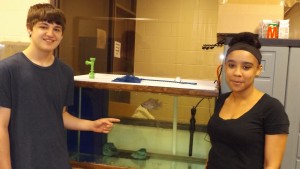‘Wow, they did all that?’ – Nebraska Teacher, Students Earn National Honors for Community Efforts
Introduction by Kathleen L. Fenton
In our last blog, we proudly featured Shawn Graham and his science students with Omaha Public Schools’ Accelere Program. He’s one of only 10 teachers in the U.S. to receive the Presidential Innovation Award for Environmental Educators. Region 7 spotlights Shawn and his students once more in this second blog, where he continues to describe their nationally-applauded efforts.

Winners of Good Earth Steward Award on Accelere’s Hydroponics Team – top row: Shawn Graham, Solangel Feuntes-Vasquez and Gabriela Hernandez, with EPA presenter Kathleen Fenton; middle row: Brittany Merrill and Breonna Berry; bottom row: Colton Hannon and Madyson Dennis
I visited Omaha, Neb., in June 2016 to honor the school, Shawn, and 21 of his students with EPA Region 7’s Good Earth Steward Award. I witnessed how Shawn engages his students about the circle of life through science classes, hydroponics lessons, and ways to give back to the environment and their community. It was a fascinating field trip.
There is an old adage: Many hands make light the work. Shawn and his Accelere students know this firsthand and their collective work is amazing! They learn about environmental science, food production, and consistently feed their community with their harvests. A noble effort!
By Shawn Graham
Our Accelere students learn about and produce plants through the hydroponic systems they created with the help of our partners, the Nebraska Academy of Science and Nebraska Environmental Trust Plant Laboratory. It was quite remarkable that the students took over an abandoned locker room just last year to build their new hydroponics lab, and have already reaped so many benefits for themselves and Omaha neighborhoods.
The school and students produce pollinator plants and food for harvesting. Last year, we produced pollinator plants worth more than $11,000 and distributed them free to the public to help others build up pollinator habitats.
Additionally, this year we supplied Black Locust trees, Comfrey, Blazing Star, and Gallardia worth $2,221 to assist our community partner, Omaha Permaculture. Their work creates healthy ecosystems through urban agriculture-related economic development, while promoting the use of unused or unwanted vacant land to elevate the property’s utility and value for the surrounding neighborhood.
Another student project underway this year is with our community partner, Nebraska Wildlife Federation, which entails growing four different species of milkweed plants worth $1,231 to assist in rounding out the pollinator habitats across Nebraska.
One of our finest, ongoing Accelere student and community efforts is working with our partners, Open Door Mission and Sol-Nest International (SI), to grow and harvest White Nile Tilapia (WNT) fish.
Our students created the hydroponics farm over this past year. Our farm and SI are now the only licensed suppliers of WNT in the entire state of Nebraska! The students received the necessary license from the Nebraska Games and Parks Hatchery to develop WNT as a protein source for the Open Door Mission’s customers.
The Open Door Mission is a nonprofit organization that serves 2,000 meals a day to the hungry and homeless in Omaha. The students have pledged $20,000 of tilapia for the future to benefit the Mission’s culinary arts program.
One of my students, Gabriela Hernandez, explains how people have reacted to this project: “Wow, they [the students] did all that?” Gabriela worked to develop the WNT program from the ground up.

Colton Hannon and Madyson Dennis created a new technique for hydroponic vegetables. Here they show off their fish, Sassy.
Students Colton Hannon and Madyson Dennis are our water quality experts, running tests to make sure all the units are running effectively. Both of them are also pioneering a new technique for growing potatoes and carrots with hydroponics.
We have 21 committed students this year, who are working, studying and producing fish and food in the Accelere Hydroponics Laboratory. I’d like to add thanks to our mentors who gave valuable help to our students. And I also want express my gratitude to our community partners. There are more than 50! Without their financial assistance, grants and guidance, none of our projects could have been completed.
“It is a lot of fun to be in Mr. Graham’s classroom,” Gabriela Hernandez said. “He listens to us and helps us learn in fun ways, while we give back to the environment.”
About the Introducer: Kathleen L. Fenton serves as the Environmental Education Program Coordinator in EPA Region 7’s Office of Public Affairs. She has worked with communities on environmental health issues, environmental education, and Healthy Schools projects for over 20 years.
About the Author: Shawn Graham is a science teacher with the Accelere Program at Omaha Public Schools in Omaha, Neb. He has been teaching 11th and 12th grade students for 13 years. Shawn’s two main goals are to generate a deeper understanding of course topics by connecting his students with the environment, and encourage students to pursue life-long learning through post-secondary education.




